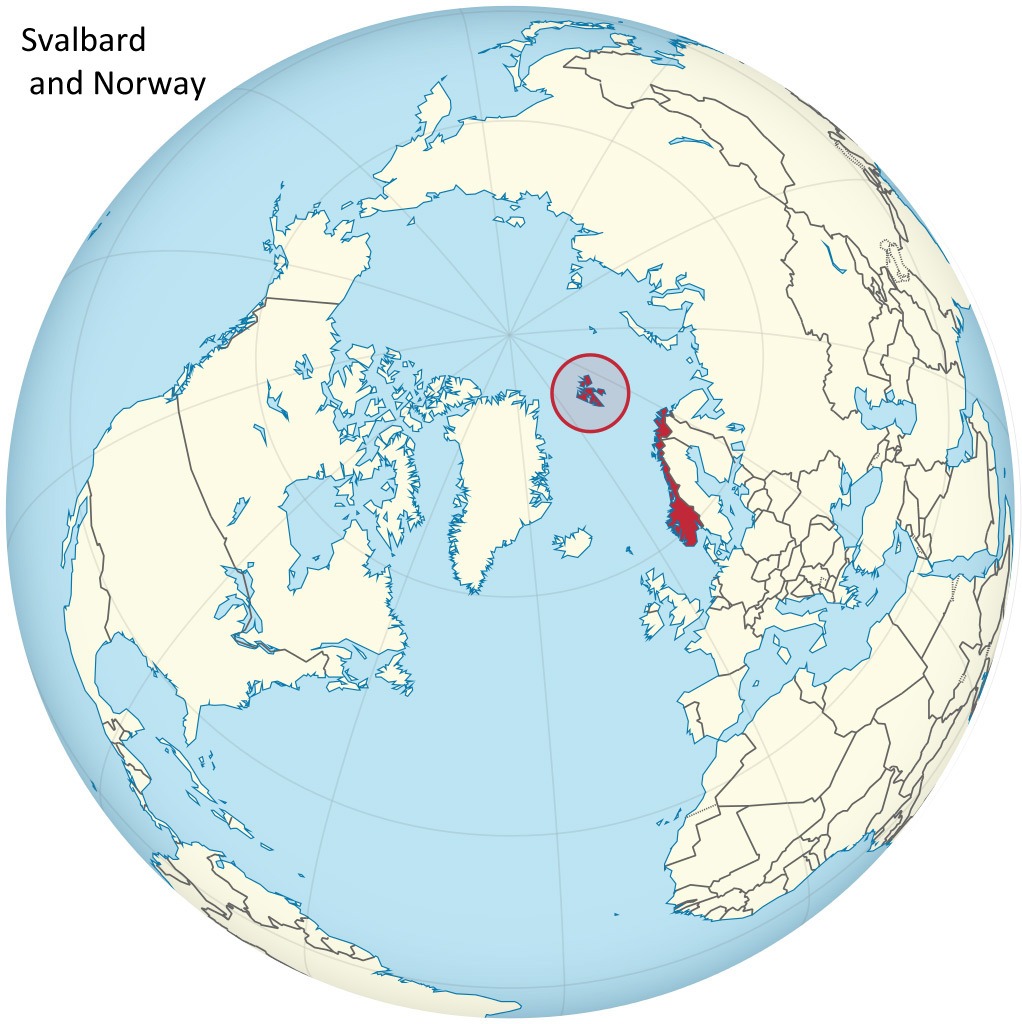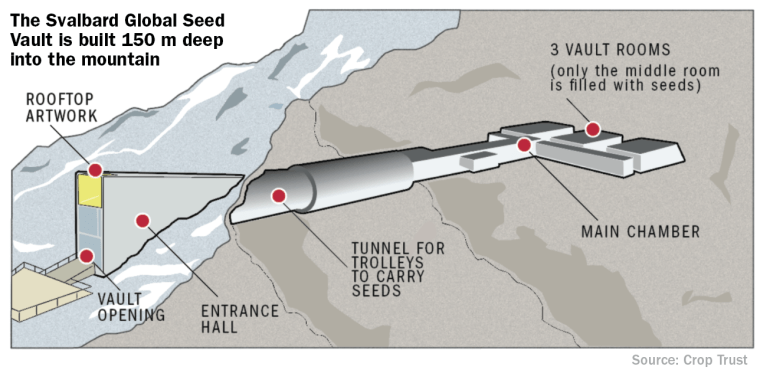The world’s environment is changing quickly but the ability of nature to adapt is far too slow. Taking precautions to ensure food security is a prudent step to safeguard the lives of many millions of people around the globe. What is also desperately needed to work alongside this effort is to reverse the current trend in warming and preserve life on Earth forever.
Download the entire lesson below in A4 PDF format:
TED Talk_ One Seed at a Time, Protecting the Future of Food
Warmer questions
- How much food do you have stored in your house? Can it last two days? Can it last for three months?
- Are crop failures very common in the world? Why or why not?
- Is it possible to produce ever more amounts of food for everyone?
- How would you protect a country’s farming from crop failure? What ways can this be averted?
Reading section
Cold storage
In the heart of an icy mountain deep within the Arctic Circle, there lives a facility that has the largest collection of seeds in the world. The underground vault is a resource for when humanity will need it to recover from crop failure or global natural disaster. The facility was built after the Iraq and Afghanistan seed banks were destroyed. It became clear that the need to have a more fortified seed bank was in dire need, and therefore further guarantee a backup for other seed banks.
There are currently over a million varieties of seeds from all over the world and is currently the guardian of the largest store of biodiversity on the planet. Bian Lainoff, coordinator of the Crop Trust which runs Svalbard seed bank recently spoke to Time Magazine saying “inside this building is 13,000 years of agricultural history”.
Location
Svalbard was deliberately chosen for its remoteness and naturally cold geography. This means that the island is not going to have many uninvited guests, few animals, and more importantly, requires no assisted cooling to keep its precious contents in hibernation. Moreover, the island’s isolation from population centers means it is away from political concerns, like terrorism, riots, robbery, and arson. Because of this, it has been named the “doomsday vault”.
The entrance is a solid concrete rectangle that pokes out of the mountain and leads to a large circular tunnel which is about 5 meters across. The concrete tunnel is lit by fluorescent strip lighting and leads down into the mountain for 150 meters.
There are three main ‘rooms’ but only one is currently in operation. Inside there are sub-zero temperatures and the room is filled with row upon row of shelves. The seeds are dried, then kept in vacuum-packed bags and kept in boxes. These seeds are the key to rejuvenating global agriculture after a catastrophe.
A library of biodiversity
Another key use for the vault is to keep a record of all known varieties of crops so that they can be used later in the future. To give an example, 30 crops today provide 95% of our energy needs. If half of those crops were to fail due to a new type of disease, then that could be a disaster.
According to Time Magazine, only 10% of the rice varieties that China used in the 1950s are still used today. The U.S. has lost over 90% of its fruit and vegetable varieties since the 1900s. With the onset of climate change, this means more drought, higher temperatures, more disease, then need to cross-bred new varieties to meet these challenges becomes ever more important.
Questions to consider
- Is having a seed bank to support other seed banks a sign that climate change is here and uncontrollable?
- Has the human desire for homogenous (meaing one type) food and diets leading to future crop insecurity?
- Is the desire for the world to have a western-style diet a reason for world crops being dependent on a few crops?
Vocabulary matching
Match the vocab on the left with the correct definitions on the right.
| Vocabulary | Definitions |
| 1. genetic diversity | a. a storage device which is secure, safe, and protects its contents. |
| 2. roll of the dice | b. a variety of plants or animals whose DNA is different from each other, either in whole or in part. |
| 3. seed bank | c. a man-made complex of buildings with a specific purpose |
| 4. vault | d. to preserve something by removing air |
| 5. catastrophe | e. types within a category |
| 6. facility | f. a place to store seeds for the future. |
| 7. vacuum-packed | g. to allow nature to produce variations, a high level is important and desirable. |
| 8. varieties | h. a saying which means the outcome of an event can be either good or bad, but not neutral. |
| 9. biodiversity | i. a disaster either natural or man-made |
| 10. isolated | j. to be away from others or populated places |
Vocabulary gap-fill
Using the words in the previous exercise fill in the gaps below.
- Not having a global seed bank to act as a backup in case of a regional disaster is a _______________________.
- Svalbard is located far from population centers because it is a ______________________.
- With the onset of Climate Change the chances of regions around the world being affected by an ecological ________________________ is far higher than before.
- Svalbard is _________________________ on an island, which is perfect to keep curious visitors away.
- The Svalbard ‘doomsday’ vault currently has over 100,000 ______________________ of rice seeds.
- In order to preserve the precious cargo of seeds from around the world, the Norwegian government paid for a _______________________ to be made in a remote region of the territory.
- The facility is placed deep inside a frozen mountain and spans three rooms which act as a _________________________ to secure agricultural diversity for the world.
- Scientists are hoping to have a record of _____________________ of all global crops.
- Many agricultural crops today are considered monocultural as vast amounts of land is used for a single type of plant. The seed bank is an attempt to preserve crop ___________________________ biodiversity for future use.
- When the seeds arrive at the facility they are often dried to ensure there is little moisture and then _____________________________ in sealed silver-coloured bags.
TED Talk: One seed at a time, protecting the future of food
The wheat, corn, and rice we grow today may not thrive in a future threatened by climate change. Cary Fowler takes us inside the Svalbard Global Seed Vault, a vast treasury buried within a frozen mountain in Norway, that stores a diverse group of food-crop seeds … for whatever tomorrow may bring.
Watch the video and then answer the questions below
- According to Fowler what is the biological foundation of agriculture?
- How many types of beans are there?
- How many varieties of apples from the 1800s have now become extinct?
- How does he describe the ‘Fowler apple’?
- True or false, the coldest growing seasons are getting colder.
- Which regions does Fowler predict climate change to have the worst effects?
- What is the estimated decrease in food production in the future?
- What are the advantages of using the Svalbard seed bank?
- Who owns the seeds?
- What percentage of water supplies does agriculture take?
Advantages of using seed banks
- A greatly increased variety of seeds to be studied and have their DNA recorded for future use.
- They are able to provide entire regions with seeds which are native to the land to kick start agriculture.
- In the future, it is possible to crossbreed new types of plants from remote regions to create crops which are more resistant to drought and extreme heat.
- It can potentially help millions of people in developing countries to secure their future food source.
Disadvantages of using seed banks
- Svalbard requires highly skilled people, buildings, helicopters for transportation, fuel, equipment, and much more. All of this is expensive and requires constant funding. Without money, the vault will decay rapidly.
- The vault is itself a single point of failure. If a million seed varieties are kept there then its destruction or any minor damage can wipe out a significant portion of its records. Geographic diversity would also be better.
- The root of the problem which causes food scarcity is mainly war, poor infrastructure, and climate change. If these issues were resolved then the need for these vaults of seeds would disappear.
- There could be an over-reliance on using seed banks to develop new crop varieties instead of working with nature.
Extended discussion questions
- If your government were to build a seed vault, how much should they spend of taxpayers money to build it?
- What would happen is a private company decided to make such a facility? Who would ‘own’ the seeds? Would the company have the right to own the DNA sequence of the seeds?
- Given that most farms are only using around 30 crop types to provide most of the calories people eat, would it not be better for food security if people ate a greater variety of foods? In some countries, they eat insects and seasonal foods. Have people become accustomed to having to same foods all year round?
Potential debating topics
- Can food insecurity be improved by the international community?
- The right to food, does the state need to ensure everyone is fed?
- Public organisations have a primary role in food distribution and not the free market.
- Do commercial and private food companies provide the most nutritious foods to the public?
- The right to live without hunger and malnutrition can only be achieved if people grow their own foods and produce.



